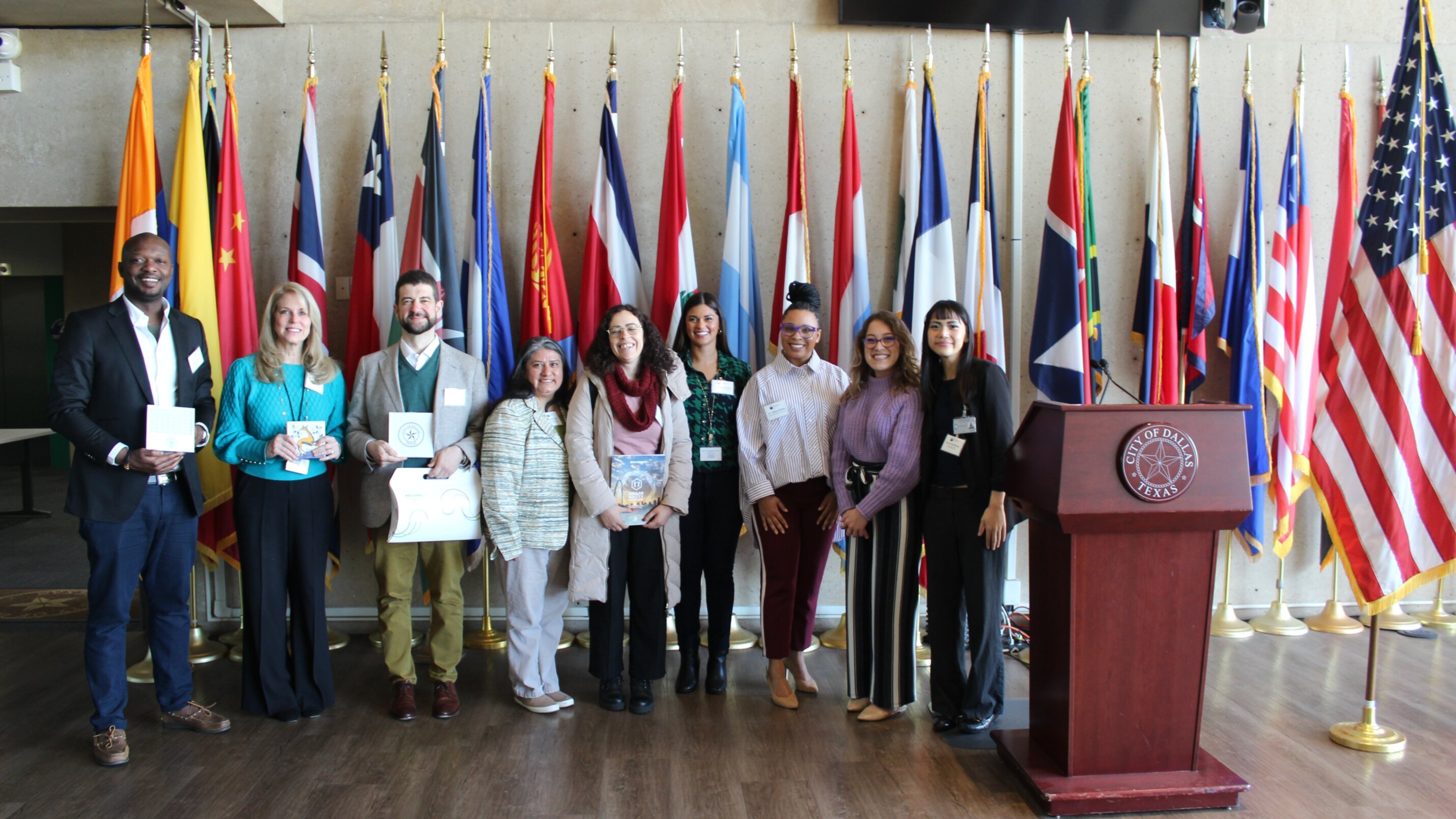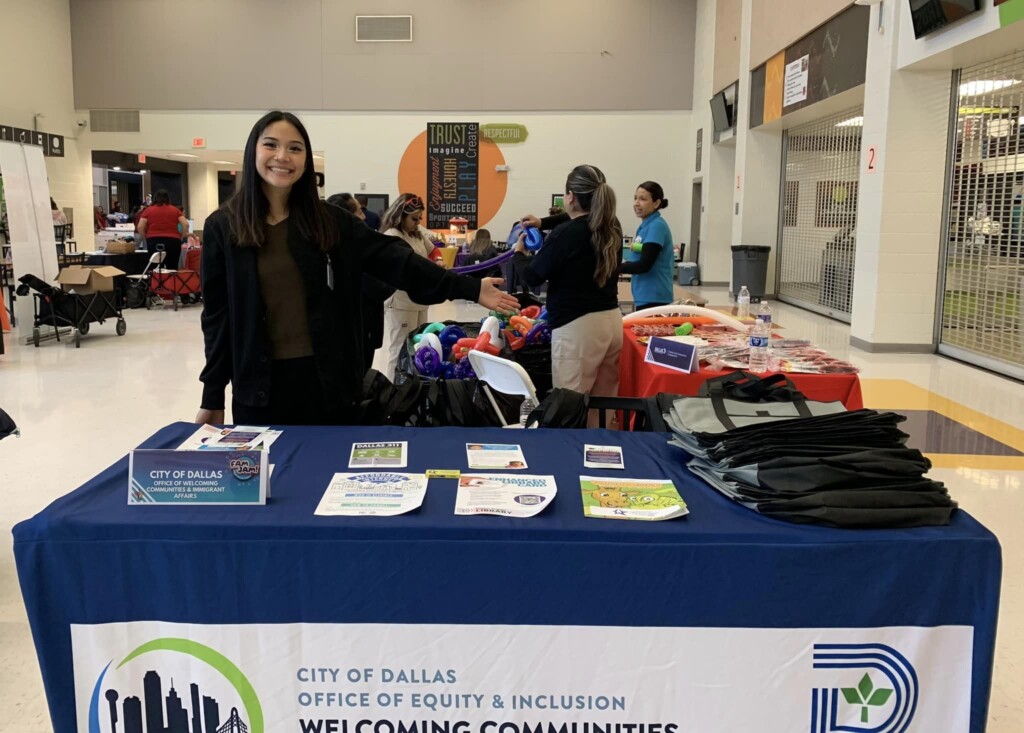
In Dallas, being welcoming takes the city into the future
Author: Maya Smith-Custer
In 2019, the City of Dallas became the first in Texas to earn the Certified Welcoming designation. As it approaches recertification this year, we spoke with Christina da Silva, Welcoming Communities and Immigrant Affairs Officer of the City of Dallas, about the steps the city took to earn the initial designation and its plans to leverage it in future welcoming work.
Background and structure
Dallas is one of the largest metro areas in the United States, as well as one of the fastest growing. According to the 2020 census, about 25% of people living in Dallas are immigrants, with most tracing their heritage to Latin America.
Because of this, the need for the City of Dallas to better include newcomers in the community became an imperative. Fortunately, the city has dedicated staff and support for immigrants through its Welcoming Community and Immigrant Affairs Division.
Whereas many large cities tend to fold immigrant affairs work within international affairs or community divisions, the Welcoming Communities and Immigrant Affairs Division is part of the city’s Office of Equity and Inclusion.
“Having a structure like this recognizes the importance of intersectionality, equity, and inclusion as part of immigrants’ identity and experience,” da Silva said.
Becoming — and staying — Certified Welcoming
In tandem with the Welcoming Dallas Strategic Plan, the City of Dallas published equity indicators. These reports consistently showed that the largest disparities were based on race, ethnicity, and geography. This led to community conversations about how to improve these outcomes.
The diverse immigrant community also means there is language diversity — 42% of households in Dallas speak a language other than English, according to da Silva. In addition to Spanish, Amharic, and Vietnamese, there are over 90 languages spoken in Dallas.
The 2019 Certified Welcoming audit recognized that, although the city provided accessible public information in Spanish, there was insufficient language access for the other most widely spoken languages in the area.
To become compliant with the equitable access framework area of the Welcoming Standard, the Office of Equity and Inclusion made sure that public information was available in languages other than Spanish and English. The city also developed a language access map that breaks down the languages most spoken by ZIP code.
“It’s important to be aware that a variety of languages exist in Dallas. The language access map shows this diversity and helps with community outreach by knowing which languages to translate materials into,” says da Silva.
Additionally, the Office of Equity and Inclusion created a Community Resources Welcoming Hub to help connect residents with education, family, legal services, and more.

The Dallas Welcoming Communities and Immigrants Affairs team shares resources with families in the Dallas Independent School District. Photo source: Facebook
Dallas’ Certified Welcoming designation is up for recertification this year. Da Silva says there remain areas of improvement in their welcoming work, namely in the civic engagement framework of the Welcoming Standard.
Advancing Dallas’ equity and inclusion efforts, the city government collaborated with community stakeholders to develop the Racial Equity Plan (REP). The plan is a strategic framework to support the city in understanding and addressing racial, ethnic, and socioeconomic disparities across Dallas. In collaboration with community, the REP will guide city departments and offices to enhance current plans, policies, and initiatives with measurable goals. As part of the REP and the Welcoming Dallas Strategic Plan, Dallas City Council approved an investment to deploy a community ambassador program. This involves contracting with local nonprofits and training people from different language communities to boost civic engagement and awareness of the resources and services available to multilingual communities.
Although the City of Dallas has made significant progress in improving language access, it still has work to do to encourage city departments to develop their own protocols for translation and interpretation.
When asked what the immediate impacts were of becoming a Certified Welcoming city — the only one in Texas so far — da Silva says it was a “sense of pride.” Since the designation was received, city employees regularly share externally that Dallas is a Certified Welcoming city. It has helped enhance community outreach, partnerships, funding, and other resources.
The future of welcoming
Dallas sees itself as a globally competitive city, with several international companies headquartered there, including AT&T, Kimberly Clark, and Southwest Airlines — many of which hire highly-skilled immigrants. It also has a strong history of the faith-based community receiving asylum seekers and refugees.
“People who are coming here through their employers from other countries could have gone anywhere, but they chose Dallas because they thought it would lead to success,” says da Silva. “Becoming Certified Welcoming was a way to demonstrate the city’s active work in the immigrant community and to formalize welcoming as a part of the community’s identity, as well as turning welcoming into an official policy.”
It even helped the city in its application to host the FIFA World Cup games in 2026. “We included our Certified Welcoming designation in the proposal as a way to demonstrate our commitment to migrants’ rights,” da Silva said. In June 2022, it was announced that Dallas would be one of 16 cities to host the games.
What’s clear is that being Certified Welcoming doesn’t end with the designation — the work must continue for cities to retain it. For places looking to become Certified Welcoming, da Silva suggests starting as early as possible by reviewing the Welcoming Standard and identifying key stakeholders.
“The Welcoming Standard has a lot of layers. At first, I didn’t know what to share for each of the framework areas. Then I thought of examples over the years with partners and included them in our application,” da Silva says. She credits the city’s Welcoming Task Force as a resource to help identify solutions and coordinate welcoming efforts. “It isn’t just one person doing this work — it has to be the community and multiple departments.”